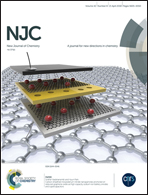Carbon sheathed molybdenum nitride nanoparticles anchored on reduced graphene oxide as high-capacity sodium-ion battery anodes and supercapacitors†
Abstract
Despite possessing excellent physical, chemical and electrical properties, early transition metal nitrides are seldom investigated as electrodes in energy storage applications, especially in sodium-ion batteries (SIBs). Herein, we report the synthesis of carbon encapsulated molybdenum nitride nanoparticles anchored on reduced graphene oxide (Mo2N@C-rGO) by a fast and facile microwave technique and their applicability as electrodes in sodium-ion batteries. Our results reveal that the hybridization of insertion and conversion type of mechanism by graphene and Mo2N, respectively, results in a high sodium-ion retention of 487.2 mA h g−1 even after 100 cycles. When applied as supercapacitor electrodes, our microwave-synthesized Mo2N@C-rGO electrodes exhibit high capacitances of 514.54 and 304.32 F g−1 at current densities of 0.25 and 10 A g−1, respectively, and long-term cyclability, with 96% capacitance retention after 3000 cycles.



 Please wait while we load your content...
Please wait while we load your content...